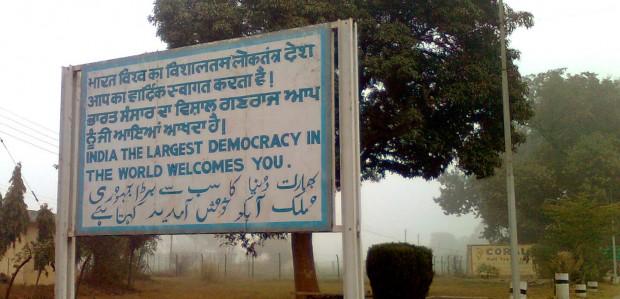Hinglish: A Case of Reverse Colonization?
A sign in Wagah, India, near the Pakistani border
English is something of an open-source language: the people who speak it shape it, and add to it. No one has the authority to exclude words.
That affects how English is spoken by its hundreds of millions of native speakers; also, how it’s spoken by those who come to it as a second or third language.
Those speakers are having a profound influence on English. Especially in country as large as India.
Many young Indians mash up English with Hindi, Punjabi or Bengali. The result is known as Hinglish.
Hinglish comes in many forms. Sometimes, you conjugate a Hindi word with an English conjugation. Sometimes you put together a 50-50 sentence—half Hindi, half English. And sometimes you “throw a choice Hindi word into a sentence that without it would lack the right amount of masala,” says Anand Giridharadas, author of India Calling.
If you’ve seen a Bollywood film, you’ve probably heard some Hinglish. Giridharadas believes that Hinglish, in this modern form, reflects India’s new-found confidence.
But what about when English first rubbed shoulders with Hindi and India’s other languages? The British ruled India for nearly 200 years. In 1886, at the height of British power, a dictionary called Hobson-Jobson was published. It was subtitled: “A glossary of colloquial Anglo-Indian words and phrases, and of kindred terms etymological, historical, geographical and discursive.”
Compiled by Colonel Henry Yule and AC Burnell, Hobson-Jobson wasn’t just a dictionary. It was a cultural snapshot, with linguistic advice for British bureaucrats and army officers.
It listed words from India that were entering English: shampoo, pajamas, dungarees, bungalow etc. The entry for the term Hobson-Jobson explains that it’s an anglicized version of something very different-sounding.
“Hobson-Jobson: My friend Major John Trotter tells me that he has repeatedly heard this phrase used by British soldiers in the Punjab. It is in fact an Anglo-Saxon version of the wailings of the Mahommedans as they beat their breasts in the procession of the Moharram. ‘Ya Hasan! Ya Hossain!’”
“There is a huge delight in language that’s evident throughout the dictionary,” says Kate Teltscher, the editor of an upcoming edition of Hobson-Jobson. That delight in language continues to be contagious. Even Indian-born writers have written about how seductive some of these mixed-up words are. Salman Rushdie wrote that it nearly made him regret the passing of empire in India.
But you just can’t get away from the linguistic power plays in Hobson-Jobson. “There is an almost innate sense of British cultural superiority.” says Teltscher
It’s in the phrases that made their way into English, and even in the use of verbs. For example, the authors note something strange that happens to some verbs when they traveled into English. “They are often in the imperative form, says Teltscher. “They are giving orders.” This often happens with words associated with violence, like the words for to bully, and to lay hold, “usually of a recalcitrant native.”
“All this language obviously relates to British colonial role,” says Teltscher.
Of course, most of the words used by the British in India were English. But they sometimes took on new shades of meaning. Hobson-Jobson sought to explain those words too.
Take the entry for the word home:
“Home. Home always means England. Nobody calls India home. Not even those who have been there 30 years or more, and are never likely to return to Europe.”
Javed Majeed of Kings College, London, says the entry reveals that the British “never became a hybridized elite” in India. But he says that other entries in Hobson-Jobson suggest that, despite certain misgivings, India did become home for many British “because of the long periods of service there…and because they’re dealing with India in quite a lot of detail.”
Majeed views Hobson-Jobson as a “careful balancing act.” It captures the colorfulness and the creativity of the slang of the time. But at the same time, “it has to guard against going native and becoming vulgar.”
At times, the authors of Hobson-Jobson complain of undesirable words from India “insinuating themselves” into English—words like calico, chintz and gingham which Hobson-Jobson warned were “lying in wait for entrance into English literature,” as if to impose some kind of linguistic reverse colonization.
No-one called Hobson-Jobson a study of Hinglish. The word Hinglish didn’t exist—which is just as well. In today’s Hinglish, there’s no longer colonial control of the language. And it’s Indians who are selecting the words, and how and when to jump between languages.
But Anand Giridharadas says the use of Hinglish in India—as well the use of much more English—can be misinterpreted. “We tend to assume from the outside that when countries modernize and have growth and get on the cover of Newsweek and Time that they’re becoming more Western,” he says. “My experience in India suggests otherwise.”
English these days is spoken with different accents—American and local. English suffixes, and sometimes whole phrases, are added to Hindi.
“My cousins in India feel more comfort speaking Hinglish and mixing Hindi into their English, and speaking without the British accent that my parents were taught, than my parents generation,” says Giridharadas. “That’s actually about self-belief and self-confidence—which is also part of the fuel of India’s rise.”
Indian English may have its roots in a history of imperial rule but it doesn’t sound like that any more. It sounds light and playful.
